Spinal Cord Stimulator Improves Chronic Pain 95%
| The first thing Michael Foote, 48, can remember is the pain.
One second, he was reaching to re-arrange cargo in the back of his truck while stopped under an overpass during a rainstorm, his wife holding onto his beltloop to steady him. The next thing he knew, he was rolling across concrete in incredible pain. He had been hit by a passing vehicle and had clearly gone airborne, but that part of the story is a blank for him.
“My first thought was the pain,” said Foote, who lives in Benton. “My second thought was, ‘my life will never be the same.’ My next thought was to call on God for help.”
Fast forward to early 2019 when a series of coincidences led him to ask his pain specialist about spinal cord stimulators. He was referred to neurosurgeon Erika Petersen, M.D., who after an evaluation phase and trial run, agreed that a stimulator might be a good fit.
Foote has been blown away by the results.
“Now my life is about 95% pain free,” Foote said. “Before, the pain was just phenomenal. I had a nurse say it’s surprising I never turned to street drugs to deal with it, it was that bad. And now – what a difference. My pain just kept melting away.”
Since the day of the accident in June 2016, pain was a constant part of Foote’s life. The accident nearly ripped off one leg and broke the other. His pelvis was crushed. He had broken bones from his toes to his teeth. He has had 24 surgeries in the years since.
“I have had so many miracle moments along the way that you wouldn’t believe it. My life feels like a movie sometimes,” Foote said. “I’ve been asked by churches to speak, that’s how unbelievable some of it has been. I used to be ashamed of my leg. But how can you hide that? A miracle, a blessing from God. I’m not ashamed anymore.”
Regis L. Renard, M.D., an orthopaedic trauma surgeon, did a lot of the work to put Foote back together, including helping him fight off a flesh-eating bacteria. Plastic surgeon Keith G. Wolter, M.D., Ph.D., moved calf muscle from the less-damaged leg to the other. For years, Foote has measured progress from one procedure to the next; by how many opioids, muscle relaxers and other medications he’s taking; and whether he’s able to walk – with a walker, one cane or two, or at all.
Petersen said often her patients are like Foote: they struggle for years without finding good solutions, only to learn about stimulators through word of mouth, usually from someone who has one. Many people don’t know they’re an option. They work best for chronic pain caused by neuropathic pain or nerve damage-related pain.
“Most people have heard of a heart pacemaker. This is a very similar technology except that the wires that come from the pacemaker pack don’t go into the heart muscle, they go into the spinal canal underneath the backbone and above the sack of spinal fluid to change how nerves process chronic pain,” Petersen said.
The small, surgically implanted device is barely detectable under the skin on most models, although patients are able to feel the place where they re-charge the battery pack by placing a paddle outside the skin. To some, surgery might sound like a last resort for chronic pain, but for those who have been dealing with it for years without benefit from other treatments, it can be the missing piece.
“Not everyone gets the same benefit as Mr. Foote. Some people say their pain is improved 30 or 50% and the stimulator is part of the mix of things they do to manage their pain,” Petersen said. “Everyone has to find that balance for themselves in terms of pain, function and quality of life. But what I like so much about the stimulators is that you can do a trial run beforehand. We can tell within about seven days if your pain is improved, which is a good way for the patient to decide if they want to proceed with the surgery.”
After the pain simulator, Foote’s goals finally are coming into sharper focus. He has been able at times to walk with just one cane, and he has been able to help with construction on the family’s home. He’s been tapering back on his medications with the help of his doctors. He feels better, more clear-headed without the pain drugs, and he hopes to be able to work again. Sitting around at home is not for him, Foote said.
“My goal is to not be taking any pills, period, within six months. From four years ago to be where I’m at now – I just have to shake my head. My God is awesome. And if it weren’t for my doctors, I wouldn’t be where I’m at now. I have had the wonderful, most awesome care I’ve ever had in my whole life with them,” Foote said, crediting Petersen, Renard and Wolter.
